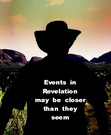Why No Third Novel in the “Tribulation Pilgrims’ Progress” Series?
Caution, possible spoilers in this posting.
The first novel in this series, “Twilight of the Church Age,” provides a fictional storyline for characters living in the period just before the Rapture of believers (which the Bible describes in 1 Corinthians 15:51-58, 1 Thessalonians 4:13-18 and Revelation 3:10). As it concludes, some of the characters have been called to heaven by Jesus in the Rapture.
Other characters (all unbelievers) were left behind by the Rapture. The second novel, “The Great New Deal,” follows these characters into the short interlude between the Rapture and the Tribulation. Some of them gain an understanding of the events and become believers in Jesus. Other characters continue to be unbelievers and some of these seem to be even more determined to reject God and pursue worldly rewards.
Though the second novel would seem to be providing the set up for a third novel (set in the Tribulation period). I don’t contemplate writing that book for the reasons I set forth in this post.
Tribulation-period novels necessarily must describe how the terrible events of the period impact the world (including the fictional characters), and dramatize the actions of the evil characters described in Bible prophecy, like the Antichrist, False Prophet, and Satan. Readers might find this interesting, and might like to follow the characters from the first two novels through the Tribulation, but I don’t think Tribulation-period fictional drama is an effective way of teaching believers about this horrific period or of helping unbelievers see their need to turn to Christ.
Further, a reader living in the Tribulation won’t benefit from the fictional depiction of the events happening around him, but would benefit from something that explains what is happening, what comes next, and what the reader should do to “survive” the Tribulation period.
E.g., a third novel might introduce the character who is revealed to be the Antichrist and describe how he comes from obscurity from a particular country- but will that fictional depiction help the believer grow in the faith or help the unbeliever see his perilous situation? Likewise, would it have any benefit to fictionally say which ocean(s) will be struck by the space object described in Revelation 8:8?
So, I decided not to write a third novel (as enjoyable as it might have been for both the author and the reader). I chose to have the key information with respect to the Tribulation period be provided by the teachers, preachers, and other fictional characters in the first two novels. Further, I’ve provided concise and reader-friendly information about the Tribulation period in the final chapter of “The Great New Deal” and in my most recent book “Lifeline, A Guide to Surviving the End Times.”
I’ve read the Tribulation-period novels by other authors and some have great characters and storylines. I like the mental exercise of comparing their storylines to the Bible, matching the events to Bible prophecies, and assessing the credibility of their speculative portrayals of details not specified in scripture. If you want to read novels that depict the Tribulation period, I’d recommend the series written by Donna VanLiere and the books by Amir Tsarfati.
At first, the “Left Behind” novels were page-turners, but as the authors stretched that series into book after book, I found them to be “too much of a good thing.” Even so, you might want to read a few of them. If you want to watch the movie adaptations of this series, I think the two best are the 2000 “Left Behind” movie starring Kirk Cameron (but not the 2014 movie) and the 2023 movie “Left Behind- Rise of the Antichrist” starring Kevin Sorbo.
Don’t watch for a third novel in the “Tribulation Pilgrims’ Progress” series. Even so, the first two novels continue to be relevant to people living in these difficult days and I hope they (and Lifeline) will be a blessing to those who read them- in these last days of the Church Age and for the “left behind” readers after the Rapture.



